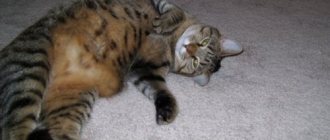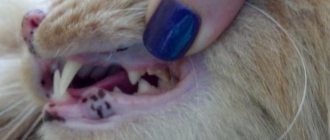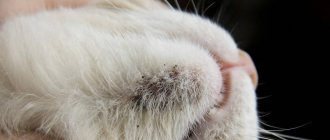What it is
Cats' teeth need to be examined periodically.
If a yellowish-brown or gray-green hard plaque is found, this is tartar. Animals in the wild do not suffer from this problem, but in domestic cats, deposits affect the incisors, side and molars.
The process begins at the base (almost at the border with the gum), gradually capturing the crown. In an advanced situation, hard plaque appears on the entire surface of the tooth.
Sediment composition
In medicine, this dental problem is called Calculus dentalis.
Stone of calcareous nature. It contains calcium carbonate mixed with phosphate.
There are also minor additions - salts of iron, phosphorus, remains of microbes, bacteria, food and other organic substances. Their presence determines the color of the plaque.
Do you need to take care of your pet's teeth?
In wild cats, teeth are cleaned naturally by chewing twigs, grass, and solid food. The owner must take care of the pet, so it is necessary to periodically brush the cat’s teeth with a special paste.
Regular procedure helps remove soft plaque, which prevents the formation of stones.
In advanced forms, the problem will have to be eliminated in a veterinary clinic.
So that the animal does not resist, it is accustomed to the hygienic procedure from infancy. Particular attention is paid to the British, Persians, Siamese, and Scottish breeds.
What to do if the animal resists
Cleaning teeth with a finger brush
Some adult cats who have never had their mouths cleaned may become very frightened by the unusual procedure and begin to resist. How to clean the teeth of a reluctant cat - possible solutions and alternatives:
- Try preparing your pet with liquid toothpaste. This product contains antibacterial particles that remove inflammation and impurities in the oral cavity in a short time. After 2-4 weeks, you can try using the brush again.
- In order for the animal to get used to friction in the mouth, it is necessary to periodically add solid food and foods to its diet.
- If the kitten escapes from your hands, you can ask someone in the household to help. One person should hold the pet's head and fingers in its mouth, the other should clean the teeth with a brush. If your pet does not want to calm down, it is better not to torture it and use liquid gels for a while.
- All actions must be performed smoothly and carefully; it is better to allocate free time and not rush anywhere. Fast movements can cause anxiety or aggression in a kitten.
- To get your pet used to cleansing products, you can let him try a small amount of it a few hours before the procedure. The pet will become familiar with the product and will not resist while cleaning its mouth.
- Before the process, you can give the cat his favorite treat, it is also worth petting him and showing your care. He will see that the owner is friendly, will not worry, and will not experience stress.
Important! If there are other pets living in the house, it is better to carry out cleaning in a separate room. Otherwise, the cat will be distracted by its own “friends” or completely disrupt the cleansing procedure.
Brushing teeth for kittens is an important and responsible procedure that helps prevent the development of infection and cleanse the oral cavity of bacteria. You can clean your teeth at home using professional cleaning products. Before choosing them, it is imperative to consult a veterinarian. He will conduct an examination, assess the situation and prescribe the necessary medications.
How is it formed in a cat?
Plaque on the teeth does not begin to harden immediately; the process takes several months. What stage of formation the deposits are at can be recognized by their shade:
First, food residues and polysaccharides settle on the teeth, in which microorganisms begin to actively multiply. Plaque is fixed through adhesion. At this stage it is still soft, yellowish in color.- Over time, the formation is covered with a film of glycoproteins, protecting the deposits from salivary enzymes. The coating gives the teeth a brownish color.
- Under the influence of bacteria trapped under the film, chemical and physical liming processes develop. As a result, the plaque hardens, turning into stone, and acquires a brown tint (in the presence of pyogenic pathogens, it may be green).
Accumulations accumulate to a greater extent on the front side of the teeth - on the inner surface, plaque is almost completely scraped off by dense pieces of food that the cat gnaws.
How serious is the problem?
Some pet owners perceive colored crowns as a cosmetic defect and are not too worried about it.
This happens due to ignorance of the dangers of limestone. Plaque does not destroy dental tissue, but it causes a lot of other troubles. An infection develops in the oral cavity, affecting the soft tissue of the alveoli and the gum mucosa.
Growths on the crowns cause mechanical irritation on the inner surfaces of the lips and cheeks, causing discomfort in cats while eating food (and not only).
As the formation grows, it penetrates under the gum, becoming the cause of gingivitis, periodontitis and other dental diseases. This causes not only an unpleasant odor from the pet’s mouth, but also leads to brittle teeth.
If you do not pay attention to the growth of stones, the cat may develop ulcers, fistulas, and abscesses on the gums. The lesions quickly grow and gradually move into the ear canals, as a result of which the animal develops otitis media.
Inflammation in the oral cavity prevents the cat from eating, and this leads to diseases of the gastrointestinal tract.
Gradually, the processes enter the purulent phase, and these accumulations spread throughout the body through the bloodstream. Having reached the brain, pus provokes death.
Why brush your cat's teeth?
Plaque is one of the most common problems faced by many pet owners. It is formed due to the use of inappropriate or hard food. Plaque not only spoils the appearance, but also promotes the growth of bacteria in the oral cavity, which leads to the formation of tartar.
Cleaning kittens' teeth
If teeth are not brushed in a timely manner, cats may develop gingivitis, stomatitis or periodontitis. These pathologies are accompanied by negative symptoms that worsen the animal’s quality of life. He develops bad breath, bleeding gums, and tooth loss. Pedigree cats, such as British cats, are especially susceptible to the disease.
Proper oral care will help prevent the development of unpleasant diseases. Therefore, before purchasing products, you should consult a veterinarian, as additional medications may be needed for specific breeds of cats.
How long does it take to form
An unpleasant plaque on the teeth can also be found in a kitten, because its diet does not yet contain solid food that would help clean off the stone. The pathology will truly manifest itself only after 4 years, when removing lime deposits will be problematic.
Not only genetically predisposed breeds are at risk, but also old or sick animals.
Options for placing stone on teeth
If you just look into a cat’s mouth, you can’t always immediately notice the problem, not knowing where to look for it. There are 2 options for the formation of stones on teeth.
Types of pathology
| Stone | Peculiarities |
| Supragingival | It is mineralized dental plaque. It is freely separated from the enamel, but, having a porous-rough surface, it is the basis for subsequent layers. Depending on the composition, it has a yellowish or brown tint. |
| Subgingival | The stone can only be detected by sanitation of the cat’s oral cavity by moving the gum away from the tooth with a dental instrument. Dark brown or black layers cover the neck of the tooth in a dense ring. The main content of the stone is hardened gingival fluid or plasma proteins |
If the formation of stones on the open surface of the tooth is associated with external factors and the composition of saliva, then growths hiding in “pockets” are a consequence of deviations in the biochemical composition of the blood serum. Therefore, this option cannot be eliminated only by hygiene procedures and a change in diet.
At what age and how to accustom a cat to brushing its teeth?
Cleaning a cat's mouth
How to give a cat an enema at home
Small kittens begin to erupt teeth after 2 weeks of life. After just 7 months, their dental composition is completely renewed. It is from this period that it is necessary to accustom pets to regular cleaning of the oral cavity.
Veterinarians say: the sooner the owner begins to carry out such a procedure, the faster the kitten will get used to it and stop resisting.
If you start cleaning at a later age, it will be much more difficult for your cat to get used to it. In such cases, the owner will need to gradually accustom her to the cleansing procedure. You need to start with bait. Before the very first cleaning, you will need to lubricate your finger with a tasty treat that the kitten loves. It is imperative to brush your teeth with your finger in the animal’s mouth. Before using the brush, it is recommended to sprinkle cleansing powders or gels into the cat’s food for several weeks, which will help normalize the microflora of the oral cavity. Only after this should you use a brush and toothpaste.
If the kitten cannot get used to the smell of the paste or gel, you can apply a small amount of cat remedy near his nose. How to brush a cat's teeth - basic rules for getting used to it:
- It is imperative to consult a veterinarian before cleaning procedures. He will suggest current remedies and medications.
- Buy a special brush and paste for animals. Human products are not suitable in this case.
- Before cleaning, you need to let the cat get acquainted with the new product, let it sniff and explore it. This will help prevent scares during the process. You can apply a little product to your pet's nose or tongue.
- It is best to cleanse on a full stomach and before bed. During this period, the kitten is in the most pliable and relaxed state, so it will practically not resist.
- If there are several pets living at home, each of them should buy their own brush. This will help avoid contamination and infection.
Important! Preparation should last for 1-3 months, depending on the fearfulness of the animal. Next, you can begin regularly brushing your teeth with a brush.
Factors contributing to plaque formation
Dental problems affecting cats are to some extent identical to those affecting humans. The owner of the animal will not discover anything new in search of reasons.
The formation of hard plaque is influenced by the following factors:
- poor oral hygiene or its complete absence;
- an ineptly prepared diet, as well as food from the master’s table;
poor quality water that is forgotten to be changed regularly;- the pet has formed an incorrect bite that does not allow self-cleaning of the teeth.
Cats are known to have a big sweet tooth, and their owners periodically pamper them with treats. But people do not realize that by giving such pleasure to an animal, they harm their health: the cat’s metabolism is disrupted, which entails not only the formation of limestone, but also more serious problems.
Preventing the formation of tartar on teeth
It is quite possible to prevent the formation of mineralized deposits in your pet’s mouth if you take timely care of its health.
The following preventive measures will help your animal avoid unpleasant procedures:
cat food is selected taking into account the physiological characteristics of the pet’s body: food must be balanced, enriched with a complex of essential vitamins and minerals;- constant brushing of teeth (2-3 times a week) using a paste based on chlorophyll and enzymes;
- Regular visits to the veterinarian in order to identify problems in a timely manner.
If you notice a slight plaque on your pet’s teeth, you should try to remove it using a suitable method. It is not advisable to feed and water the cat half an hour before the hygiene procedure.









